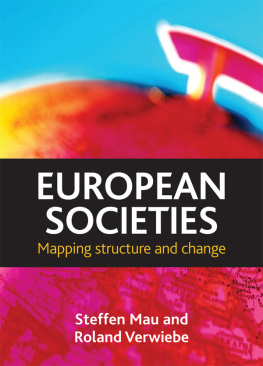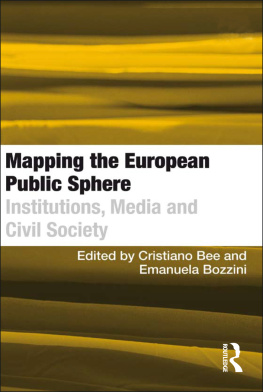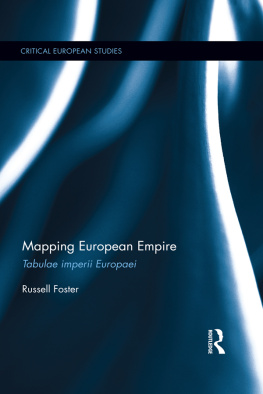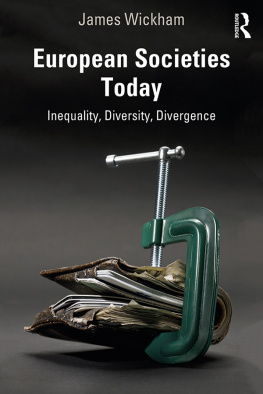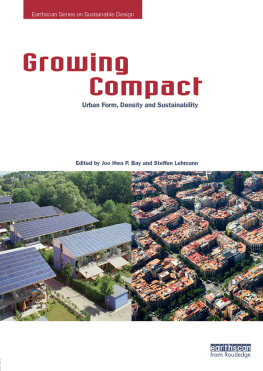EUROPEAN SOCIETIES
Mapping structure and change
Steffen Mau and Roland Verwiebe
First published in Great Britain in 2010 by
Policy Press University of Bristol 6th Floor Howard House Queens Avenue Clifton Bristol BS8 1SD UK Tel +44 (0)117 331 5020 Fax +44 (0)117 331 5367 e-mail
North American office: Policy Press c/o The University of Chicago Press 1427 East 60th Street Chicago, IL 60637, USA t: +1 773 702 7700 f: +1 773-702-9756 e:
Policy Press 2010
British Library Cataloguing in Publication Data
A catalogue record for this book is available from the British Library.
Library of Congress Cataloging-in-Publication Data
A catalog record for this book has been requested.
ISBN 978 1 44731 778 4 epub
ISBN 978 1 44731 779 1 Kindle
The right of Steffen Mau and Roland Verwiebe to be identified as authors of this work has been asserted by them in accordance with the 1988 Copyright, Designs and Patents Act.
All rights reserved: no part of this publication may be reproduced, stored in a retrieval system, or transmitted in any form or by any means, electronic, mechanical, photocopying, recording, or otherwise without the prior permission of Policy Press.
The statements and opinions contained within this publication are solely those of the authors and not of The University of Bristol or Policy Press. The University of Bristol and Policy Press disclaim responsibility for any injury to persons or property resulting from any material published in this publication.
Policy Press works to counter discrimination on grounds of gender, race, disability, age and sexuality.
Cover design by Robin Hawes
Front cover: image kindly supplied by www.alamy.com
Readers Guide
This book has been optimised for PDA.
Tables may have been presented to accommodate this devices limitations.
Image presentation is limited by this devices limitations.
Contents
List of tables
List of figures
EU-15
Austria (AT), Belgium (BE), Denmark (DK), Finland (FI), France (FR), Germany (DE), Greece (EL), Ireland (IE), Italy (IT), Luxembourg (LU), Netherlands (NL), Portugal (PO), Spain (ES), Sweden (SE), United Kingdom (UK) (without Northern Ireland: Great Britain/GB)
EU-25
EU-15, Cyprus (CY), Czech Republic (CZ), Estonia (EE), Hungary (HU), Latvia (LV), Lithuania (LT), Malta (MT), Poland (PL), Slovakia (SK), Slovenia (SI)
EU-27
EU-25, Bulgaria (BG), Romania (RO)
Our thanks go to all those who encouraged us and helped in the production of this book. We thank Martin Gross, Holger Lengfeld and Patrick Prg for reading the entire text their suggestions were very valuable. Critical comments on individual chapters were offered by Sonja Drobni, Johannes Giesecke, Katja Marjanen and Patrick Sachweh. Steffen Mau is grateful to the Social Science Research Center Berlin (WZB), in particular to Jens Alber and Jutta Allmendinger, for hosting him during the Winter Term 2009/10. Thanks go to Niels Winkler, Djubin Pejouhandeh, Nina-Sophie Fritsch and Laurenz Ennser for their great support in the collection of statistical data, the creation of graphs and figures and in the review of the relevant literature. are taken from joint publications by Steffen Mau and Sebastian Bttner. This book is a fully revised and updated version of our German text Die Sozialstruktur Europas (Konstanz: UVK, 2009). For the English-speaking market, we have brought the book up to date and also made substantial changes. Gregory Sims and Benjamin Veghte took on the challenging task of translating the book. Our thanks to them for their proficiency, their impressive abilities and the care they took in rendering our comprehensive, detailed text into English. Finally, we would like to thank Emily Watt and Jo Morton from Policy Press, who supported the project with great enthusiasm.
Steffen Mau and Roland Verwiebe
Berlin, April 2010
This book is about European societies, their structures and change. The main objectives are to describe contemporary European societies along a broad range of dimensions, highlight commonalities as well as variations, understand processes of integration and characterise the ongoing transformation of the European social space. To talk about European societies in the plural means that we not only focus on European unity or ways to achieve it, as some scholars do, but view European societies as national and European at the same time. However, we emphasise that within the European context, and particularly with the nascent European polity, national societies have been challenged and transformed fundamentally and are no longer independent entities, but closely interwoven and connected.
Taking the national and European context into consideration poses a true challenge. Most research on patterns of social change, inequality and social stratification focuses on nation-states. Core concepts of research on social stratification, for example, class, profession, income distribution, mobility and education, have been developed within the framework of the nation-state and national society. By the same token, Favell (2007: 122) states that most sociological research is still wedded to national society and that it seems to be very difficult to systematically study pan- or transnational social structures, because of the way nation-states have carved up the world and its populations, statistically speaking. However, as a result of processes of European integration, globalisation and internationalisation, the world of European nation-states has been shaken up. Hitherto focused on national societies, social science is not equipped to do justice to these processes, and this is particularly true for the process of Europeanisation. Sociology as a whole, and research into social stratification and inequality in particular, have therefore been accused of methodological nationalism (Agnew and Corbridge, 1995: 122), since they unquestioningly assume a congruence of territorial, political, cultural, economic and social boundaries:
The methodological nationalism of the sociology of inequality and research on the welfare state is as obvious as the self-containing relation between these two sociological disciplines. The basic assumption is the nation-state as the basic unit of social conflicts and their regulation by the state, generally without giving a singly thought to the presuppositions which guide research. Thanks to this analytical mindset, this kind of theory and research is blind to Europe. The result is the failure to appreciate that the mixing, blurring and redrawing of boundaries between Member States, and also between Europeans and their others, has far-reaching implications for the pan-European conflict dynamic for the question of recognition, social inequality and societal redistribution. Likewise the problems and dilemmas resulting from the intersection of these issues are not appreciated. (Beck and Grande, 2007: 174)
In this textbook, we will argue that the European Union is an important frame of reference for analysing European societies. Through European integration, that is, through exchange, integration and the development of new forms of solidarity and conflict, a new space of societal relations is being created, redefining fields of activity that previously fell within the compass of the nation-state (Heidenreich, 2006a). The EU is not just an intergovernmental arrangement for the harmonisation of markets, but also a supranational entity sui generis , which has major social consequences for the lives of people in the member countries and their chances of prosperity. As Medrano (2008: 4) puts it:


